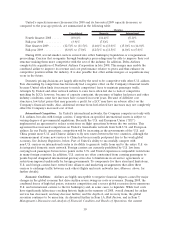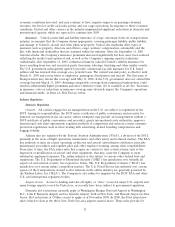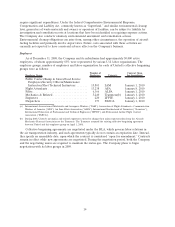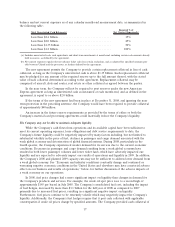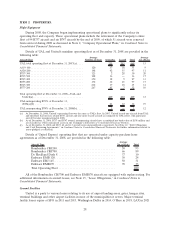United Airlines 2008 Annual Report Download - page 20
Download and view the complete annual report
Please find page 20 of the 2008 United Airlines annual report below. You can navigate through the pages in the report by either clicking on the pages listed below, or by using the keyword search tool below to find specific information within the annual report.divestitures and business combinations. In 2008, the Company announced its agreement to form a
strategic alliance with Continental Airlines. This alliance may not realize all of the benefits of a merger.
The Company may have future discussions with other airlines regarding mergers and/or other strategic
alternatives. If other airlines participate in merger activity, and United does not, those airlines may
significantly improve their cost structures or revenue generation capabilities, thereby potentially making
them stronger competitors of United.
In addition, United and certain of its competitors announced significant capacity reductions during
2008. The Company may not achieve necessary increases in unit revenue from the announced capacity
reductions and unit costs may be adversely impacted by capacity reductions. Further, certain of the
Company’s competitors may not reduce capacity or may increase capacity, thereby diminishing our
expected benefit from capacity reductions. The poor economic environment may have an adverse impact
on travel demand, which may result in a negative impact on revenues.
Additional security requirements may increase the Company’s costs and decrease its revenues and traffic.
Since September 11, 2001, the DHS and the Transportation Security Administration have
implemented numerous security measures that affect airline operations and costs and are likely to
implement additional measures in the future. In addition, foreign governments have also instituted
additional security measures at foreign airports United serves. A substantial portion of the costs of these
security measures is borne by the airlines and their passengers, increasing the Company’s costs and/or
reducing its revenue and traffic. Additional measures taken to enhance either passenger or cargo security
procedures and/or to recover associated costs in the future may result in similar adverse effects on
United’s results of operations.
Extensive government regulation could increase the Company’s operating costs and restrict its ability to conduct
its business.
Airlines are subject to extensive regulatory and legal compliance requirements that result in
significant costs. In addition to the enactment of the Aviation Security Act, laws, regulations, taxes and
airport rates and charges have been proposed from time to time that could significantly increase the cost
of airline operations or reduce airline revenue. The FAA from time to time also issues directives and
other regulations relating to the maintenance and operation of aircraft that require significant
expenditures by United. The Company expects to continue incurring material expenses to comply with
the regulations of the FAA and other agencies.
United operates under a certificate of public convenience and necessity issued by the DOT. If the
DOT altered, amended, modified, suspended or revoked our certificate, it could have a material adverse
effect on the Company’s business. The FAA can also limit United’s airport access by limiting the number
of departure and arrival slots at “high density traffic airports” and local airport authorities may have the
ability to control access to certain facilities or the cost of access to such facilities, which could have an
adverse effect on the Company’s business.
In addition, access to landing and take-off rights or “slots” at several major U.S. airports and many
foreign airports served by United are, or recently have been, subject to government regulation. As
passenger travel has continued to increase in recent years, many U.S. and foreign airports have become
increasingly congested. Certain of United’s major hubs are among the more congested airports in the
U.S. and have been or could be the subject of regulatory action that might limit the number of flights
and/or increase costs of operations at certain times or throughout the day.
In addition, the Company’s operations may be adversely impacted due to the existing outdated air
traffic control (“ATC”) system utilized by the U.S. government. During peak travel periods in certain
markets the current ATC system’s inability to handle existing travel demand has led to short-term
capacity constraints imposed by government agencies, as discussed above, and has also resulted in delays
and disruptions of traffic using the ATC system. In addition, the current system will not be able to
effectively handle projected future air traffic growth. Therefore, imposition of these ATC constraints on
20


